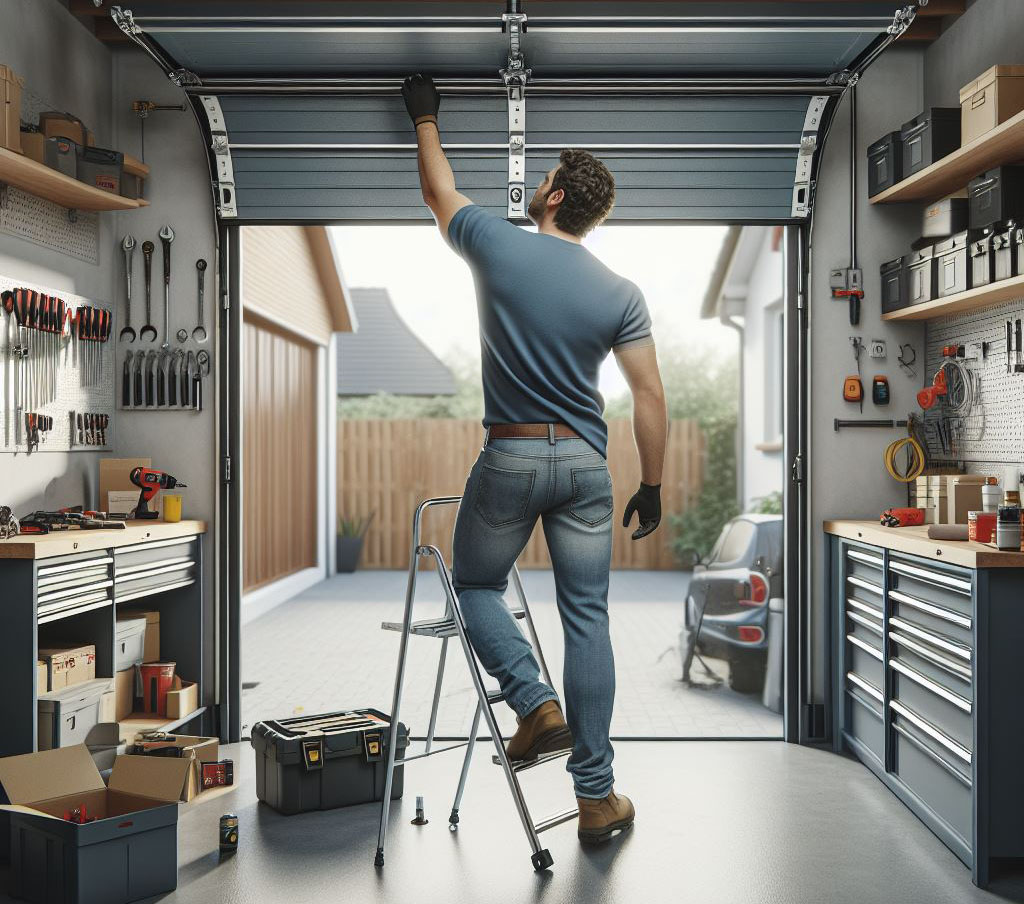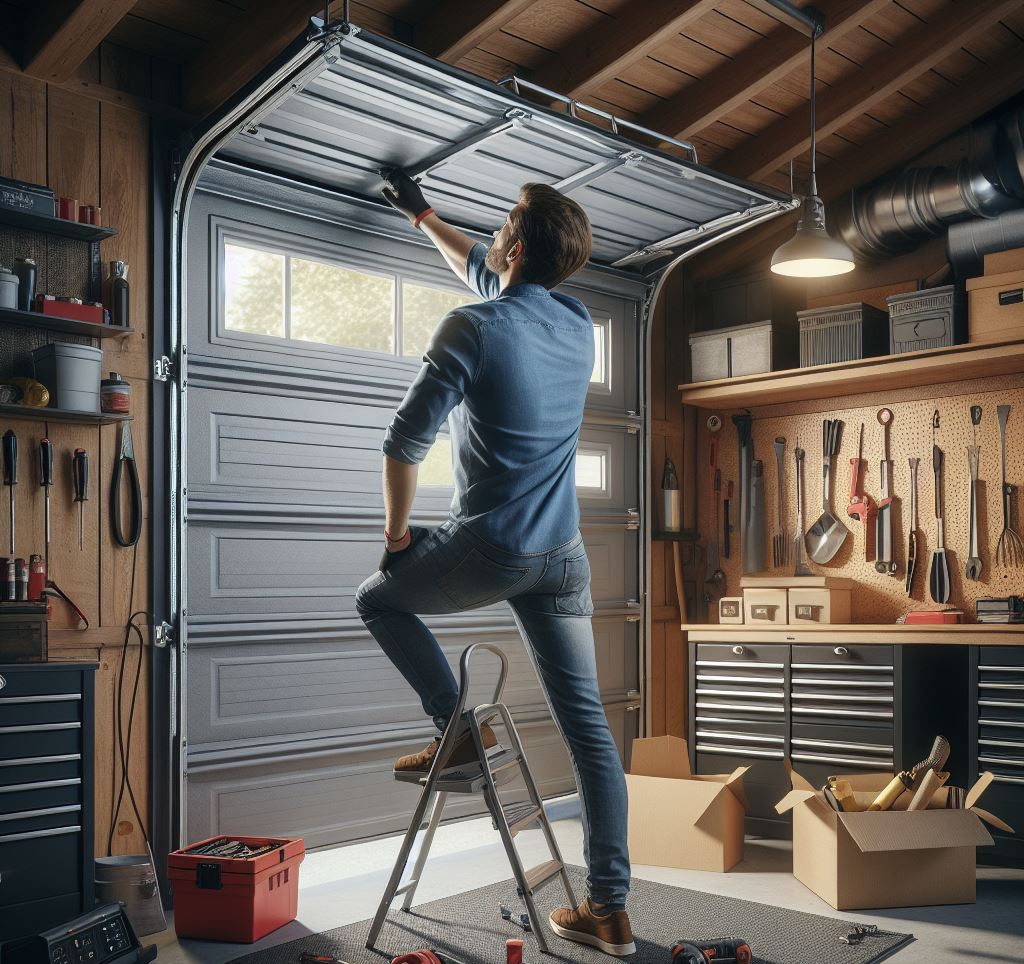When it comes to the integral parts of your home, the garage door is often an unsung hero. It’s not just a panel that opens and closes; it’s a critical component of your home’s security and energy efficiency. However, like any frequently used part of your home, it can develop issues, particularly with closing. These problems, while common, can disrupt your daily routine and compromise your home’s security.
In this article, we’ll delve into the practical, hands-on solutions that empower both DIY enthusiasts and professional handymen to tackle garage door issues with confidence. We’ll dissect the mechanics, pinpoint common problems, and provide you with the tools and knowledge to fix them.

Understanding Garage Door Mechanics
To effectively address any garage door issue, it’s essential to understand its basic operation. Here’s a breakdown:
- Tracks and Rollers: These guide the door’s movement. If they’re misaligned, your garage door won’t glide smoothly.
- Springs and Cables: These components counterbalance the door’s weight, facilitating its opening and closing. A failure here can render the door inoperable.
- Door Opener: This device, typically mounted overhead, controls the door’s automatic opening and closing, usually operated via a remote.
Common Reasons Why Garage Doors Won’t Close
Identifying the root cause is half the battle. Here are some usual suspects:
- Sensor Obstruction or Misalignment: Safety sensors ensure nothing is in the door’s path. If they’re obstructed or misaligned, the door will refuse to close for safety reasons. Regular checks and alignments are key.
- Track Misalignment or Damage: A door off its track or moving along damaged rails is a recipe for malfunction. Routine inspections can help identify and correct these issues early on.
- Spring and Cable Issues: Given their critical role in door operation, any damage to springs and cables can be problematic. These are high-tension parts, so exercise caution and consider professional help if they need fixing.
- Remote Control Problems: Sometimes, the issue is as simple as a dead battery in the remote. Other times, interference or programming issues can occur. Regular remote maintenance is a small but crucial task.
In conclusion, while garage door issues are a common nuisance, they are often within the realm of DIY repair. With a bit of know-how, the right tools, and safety precautions, you can ensure your garage door operates smoothly and reliably. However, never hesitate to consult a professional for complex or risky problems. With this guide, you’re well-equipped to handle the most common garage door woes, maintaining the security and functionality of your home.

Step-by-Step Troubleshooting Guide
Checking and Aligning Sensors
Let’s start with the sensors, a common culprit in garage door issues. These little devices can be finicky, but with a few simple steps, you can get them back on track:
- Locate the Sensors: Typically found on either side of the door, close to the ground.
- Clean the Lenses: Gently wipe each sensor lens with a clean cloth. Dust and grime can obstruct their view, causing false alarms.
- Ensure Alignment: Using a level, check that the sensors are parallel to each other. A misalignment, even a slight one, can disrupt their signaling. If they’re off, gently adjust them until they’re properly aligned.
- Test the Door: After adjusting, run a door close cycle to see if the problem is resolved.
Inspecting and Adjusting Tracks
The tracks guide your garage door and must be properly aligned for smooth operation. Here’s how to check and adjust them:
- Examine the Tracks: Look for bends, gaps, or obstructions. Even a small bend can lead to big problems.
- Tighten the Hardware: Use a wrench to tighten all the bolts and screws along the tracks. Loose hardware can lead to misalignment.
- Adjust as Needed: If you find a bend, gently coax it back into place with a pair of pliers. Be careful not to overcorrect.
- Check the Rollers: Worn rollers can cause issues, too. If they’re damaged or not rolling smoothly, consider replacing them.
Assessing Spring and Cable Condition
The springs and cables of your garage door are critical for its proper functioning, but they can be dangerous. Proceed with caution:
- Safety First: Remember, these parts are under high tension. If you’re not comfortable, seek professional help.
- Inspect for Damage: Look for signs of wear, like frayed cables or gaps in the spring coils.
- Balance Test: Disconnect the automatic opener and lift the door halfway manually. It should stay in place. If it falls, the springs may need adjusting or replacing.
- Professional Help: If you’re unsure or find significant issues, it’s best to call in a professional. Dealing with high-tension springs and cables requires special tools and expertise.
Remote Control and Opener Checks
Finally, let’s not overlook the remote control and opener, often the simplest fix of all:
- Change the Batteries: Start with the basics. Replace the batteries in the remote.
- Reprogramming: If new batteries don’t do the trick, reprogramming the remote is the next step. Refer to your manual for specific instructions.
- Check the Opener: Ensure the opener’s antenna is hanging down and unobstructed.
- Wall Switch Test: If the door operates with the wall switch but not the remote, the issue likely lies with the remote. If neither works, the problem might be with the opener itself.
Preventive Maintenance Tips
In my years of handling renovation and construction, I’ve learned that the longevity of a garage door heavily relies on regular upkeep. Here’s how to keep your garage door operating smoothly:
- Routine Inspections: Like a seasoned doctor’s regular health check, your garage door needs consistent inspections. Once a month, take a moment to scrutinize it for any signs of wear and tear or loose components. Catching issues early can save you a headache later.
- Lubrication is Key: Think of lubrication as the lifeblood of your garage door. Every couple of months, apply a silicone-based lubricant to the moving parts – the springs, rollers, and hinges. This not only ensures smooth operation but also prevents rust and corrosion.
- Keeping Tracks Clear: Just as a clean home is a happy home, clean tracks are essential for a happy garage door. Use a cloth and a mild cleaner to remove any dirt or debris from the tracks. This simple act can prevent many common door issues.
- Recognizing When to Call a Professional: In the world of DIY, knowing your limits is vital. Complex issues like broken springs or significant electrical faults require a professional’s expertise. It’s about balancing enthusiasm with safety and practicality.
FAQ Section
This problem is often linked to sensor issues. Ensure nothing is blocking the sensors and check for alignment. Another aspect to consider is the opener’s sensitivity. If set too high, it can cause the door to reverse upon encountering minor resistance.
Indeed, weather plays a significant role. Cold temperatures can stiffen lubricants and shrink metal components, while heat can expand them. Adjust your maintenance strategy with the changing seasons to accommodate these variations.
This typically points to an issue with the remote control. Start with the simplest solution – replacing the batteries. If that doesn’t work, reprogramming the remote or replacing it might be necessary.
First, ensure there are no visible obstructions or disconnections. If the problem isn’t immediately apparent, it could be an issue with the opener or the door’s balance. In such cases, it’s safer and wiser to consult a professional.
I recommend a comprehensive maintenance check at least twice a year. Regular lubrication, wear and tear checks, and alignment adjustments are crucial. Remember, consistent maintenance can significantly extend the life of your garage door.
